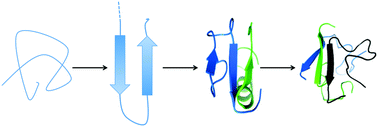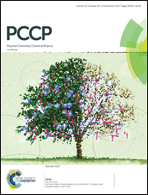Structural and thermodynamical properties of early human amylin oligomers using replica exchange molecular dynamics: mutation effect of three key residues F15, H18 and F23†
Abstract
Human islet amyloid polypeptide (hIAPP) is a 37-residue polypeptide, considered to be the main component of the pancreatic islet amyloid associated with type 2 diabetes and is one of the most amyloidogenic polypeptides known. Although the structure of hIAPP fibrils has already been obtained, structures of early oligomers and the mechanism of β-sheet formation remain poorly understood. Herein, we characterize the atomic structure and the thermodynamics of the 14–37 residue fragment of hIAPP wild-type and mutated dimers and trimers. More precisely, three key residues, F15, H18 and F23, thought to affect the aggregation process, are the focus of this numerical study using replica exchange molecular dynamics coupled with the OPEP coarse-grained protein force field. Our simulations show that the oligomerization process takes place through the formation of anti-parallel β-sheets most probably between C-terminal regions. Two main characteristics are associated with the onset of the fibrillation process. First, the sequence matching between the central (20–29) and C-terminal (30–37) regions, at intra and inter-molecular levels, helps in stabilizing the secondary structure and facilitates intermolecular interactions. Second, hydrophobic residues I26 and L27 are likely to promote the capture of further oligomeric structures and thus facilitate fibril elongation. Histidine mutation should have a more pronounced effect in the N-terminal region while phenylalanine mutations do not seem to prevent amyloid formation since central/C-terminal interactions are conserved through other contacts.



 Please wait while we load your content...
Please wait while we load your content...